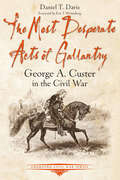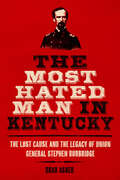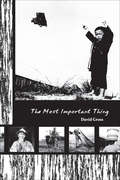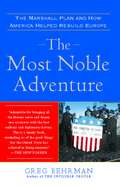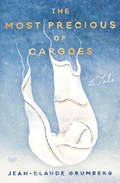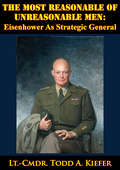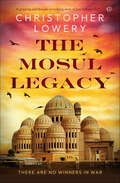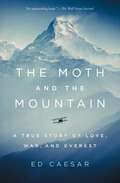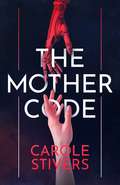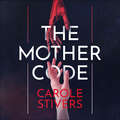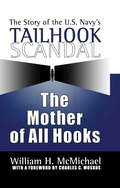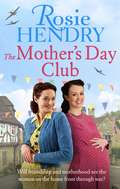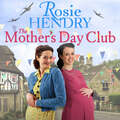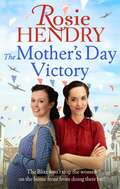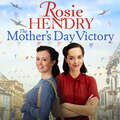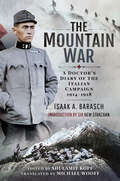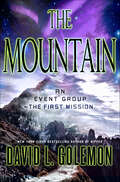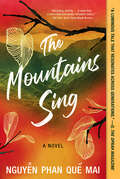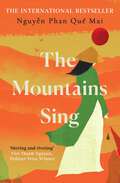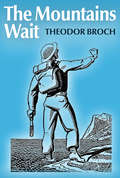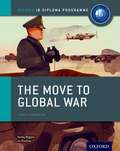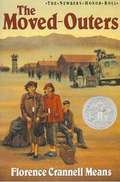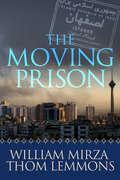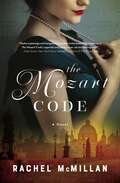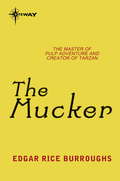- Table View
- List View
The Most Desperate Acts of Gallantry: George A. Custer in the Civil War (Emerging Civil War Series)
by Daniel T. Davis“Presents Custer’s Civil War accomplishments in clear and engaging prose, while its ample images and battle maps place unfamiliar readers in the action.” —The Civil War MonitorThrough the passage of time, Lt. Col. George Armstrong Custer’s last fight, the Battle of the Little Bighorn in 1876, has come to overshadow the rest of his military career, which had its brilliant beginning in the American Civil War.Plucked from obscurity by Maj. Gen. George McClellan, Custer served as a staff officer through the early stages of the war. His star began to rise in late June, 1863, when he catapulted several grades to brigadier general and was given brigade command. Shortly thereafter, at Gettysburg and Buckland Mills, he led his men—the Wolverines—in some of the heaviest cavalry fighting of the Eastern Theater.At Yellow Tavern, Custer’s assault broke the enemy line, and one of his troopers mortally wounded the legendary Confederate cavalryman, J.E.B. Stuart. At Trevilian Station, his brigade was nearly destroyed. At Third Winchester, he participated in an epic cavalry charge. Elevated to lead the Third Cavalry Division, Custer played a major role at Tom’s Brook and, later, at Appomattox, which ultimately led to the surrender of the Army of Northern Virginia.Historian Daniel T. Davis, a long-time student of George Custer, has spent countless hours walking and studying the battlefields where Custer fought in Virginia, Maryland, and Pennsylvania. In The Most Desperate Acts of Gallantry, he chronicles the Civil War experiences of one of the most recognized individuals to emerge from that tragic chapter in American history.“A fast-paced study, engaging study.” —Journal of the Shenandoah Valley During the Civil War Era
The Most Hated Man in Kentucky: The Lost Cause and the Legacy of Union General Stephen Burbridge
by Brad AsherA revealing biography of Stephen Gano Burbridge, the controversial Union Army general known as the “Butcher of Kentucky.”For the last third of the nineteenth century, Union General Stephen Gano Burbridge enjoyed the unenviable distinction of being the most hated man in Kentucky. From mid-1864, just months into his reign as the military commander of the state, until his death in December 1894, the mere mention of his name triggered a firestorm of curses from editorialists and politicians. By the end of Burbridge’s tenure, Governor Thomas E. Bramlette concluded that he was an “imbecile commander” whose actions represented nothing but the “blundering of a weak intellect and an overwhelming vanity.”In this revealing biography, Brad Asher explores how Burbridge earned his infamous reputation and adds an important new layer to the ongoing reexamination of Kentucky during and after the Civil War. Asher illuminates how Burbridge?as both a Kentuckian and the local architect of the destruction of slavery?became the scapegoat for white Kentuckians, including many in the Unionist political elite, who were unshakably opposed to emancipation. Beyond successfully recalibrating history’s understanding of Burbridge, Asher’s biography adds administrative and military context to the state’s reaction to emancipation and sheds new light on its postwar pro-Confederacy shift.“A solid reassessment of Kentucky’s most controversial and reviled Union general, and one that will help readers understand the state’s complex place (and Burbridge’s complex place) in Civil War history.” —Stuart W. Sanders, author of Murder on the Ohio Belle“A superb biography of one of the most pivotal figures in Kentucky’s Civil War history. . . . There has been a lot of revisionist literature in the last fifteen years on Kentucky’s belated Confederate identity but no work up to now has addressed Burbridge himself. Brad Asher has filled a very important gap in the literature on wartime and postwar memory of Kentucky.” —Aaron Astor, author of Rebels on the Border: Civil War, Emancipation and the Reconstruction of Kentucky and Missouri, 1860–1872“Asher does a terrific job of weaving together the military, political, social, and economic threads that made Kentucky such a complex story in and of itself during the Civil War.” —Emerging Civil War Book Reviews
The Most Important Thing: The Most Important Thing (The\most Important Thing Ser.)
by David GrossIn this novel based on true events, a young man from rural Kentucky discovers what matters most in life as a soldier in the Korean War.In January of 1950, Bradley leaves his family’s Kentucky farm to join the US Army. He’s eighteen years old and eager for adventure, new horizons, and a bigger paycheck. His service takes him halfway across the world to serve in the Korean War. It is there, amidst the perils of battle, that he discovers the most important thing.In The Most Important Thing author David Gross parlays his own father’s life history into a moving novel about a young man’s coming of age. It is a powerful story of resilience that explores the meaning of service, sacrifice, and heroism.
The Most Noble Adventure: The Marshall Plan and the Time When America Helped Save Europe
by Greg BehrmanIn this landmark, character-driven history, Greg Behrman tells the story of the Marshall Plan, the unprecedented and audacious policy through which America helped rebuild World War II-ravaged Western Europe. With nuanced, vivid prose, Behrman recreates the story of a unique American enterprise that was at once strategic, altruistic and stunningly effective, and of a time when America stood as a beacon of generosity and moral leadership. When World War II ended in Europe, the continent lay in tatters. Tens of millions of people had been killed. Ancient cities had been demolished. The economic, financial and commercial foundations of Europe were in shambles. Western Europe's Communist parties -- feeding off people's want and despair -- were flourishing as, to the east, Stalin's Soviet Union emerged as the sole superpower on the continent. The Marshall Plan was a four-year, $13 billion (more than $100 billion in today's dollars) plan to provide assistance for Europe's economic recovery. More than an aid program, it sought to modernize Western Europe's economies and launch them on a path to prosperity and integration; to restore Western Europe's faith in democracy and capitalism; to enmesh the region firmly in a Western economic association and eventually a military alliance. It was the linchpin of America's strategy to meet the Soviet threat. It helped to trigger the Cold War and, eventually, to win it. Through detailed and exhaustive research, Behrman brings this vital and dramatic epoch to life and animates the personalities that shaped it. The narrative follows the six extraordinary American statesmen -- George Marshall, Will Clayton, Arthur Vandenberg, Richard Bissell, Paul Hoffman and W. Averell Harriman -- who devised and implemented the Plan, as well as some of the century's most important personalities -- Winston Churchill, Josef Stalin, Joseph McCarthy -- who are also central players in the drama told here. More than a humanitarian endeavor, the Marshall Plan was one of the most effective foreign policies in all of American history, in large part because, as Behrman writes, it was born and executed in a time when American "foreign policy was defined by its national interests and the very best of ideals."
The Most Precious of Cargoes: A Tale
by Jean-Claude GrumbergSet during the height of World War II, a powerful and unsettling tale about a woodcutter and his wife, who finds a mysterious parcel thrown from a passing train.Once upon a time in an enormous forest lived a woodcutter and his wife. The woodcutter is very poor and a war rages around them, making it difficult for them to put food on the table. Yet every night, his wife prays for a child.A Jewish father rides on a train holding twin babies. His wife no longer has enough milk to feed both children. In hopes of saving them both, he wraps his daughter in a shawl and throws her into the forest.While foraging for food, the wife finds a bundle, a baby girl wrapped in a shawl. Although she knows harboring this baby could lead to her death, she takes the child home.Set against the horrors of the Holocaust and told with a fairytale-like lyricism, The Most Precious of Cargoes is a fable about family and redemption which reminds us that humanity can be found in the most inhumane of places.Translated from the French by Frank Wynne
The Most Reasonable Of Unreasonable Men: Eisenhower As Strategic General
by Lt.-Cmdr. Todd A. KieferThis paper investigates General Dwight D. Eisenhower's roles as strategist and strategic general during World War II. Eisenhower had zero combat experience and was still a colonel on the Army rolls when selected for four-star unified command. Yet, he fought and won the war in Europe on his own terms. He designed his own chain of command, drafted the terms for Allied cooperation and strategy, built the Allied command structure, disobeyed heads of state, engaged in military diplomacy with political enemies, and enforced his personal morality upon an entire theater of war. He was the field commander for four great campaigns including the first Allied effort in North Africa and the final drive from the English Channel to the Elbe. In his humble and disarming way, Eisenhower was the most unreasonable general of all time.This study concludes that Eisenhower was an unconventional military thinker whose success as strategic general was due primarily to his capacity for progressive and creative vision. His extraordinary personal energy, initiative, creativity, and integrity enabled him to translate his unique vision into reality.
The Mosul Legacy
by Christopher LoweryThere are no winners in war… Mosul, Iraq, 2016: Once ISIL's greatest conquest, the city is fast becoming a giant graveyard. As Western attacks devastate the city, even senior officers like Karl realise defeat is inevitable, while traumatised families find themselves displaced, looking for somewhere safe to call home. On Karl&’s instructions, two jihadists travel across the EU, planning to bring terror to the West. German police officer Max Kellerman is on their trail, but can he find them in time to prevent a catastrophic terrorist attack? Meanwhile, the Al-Douri family flee Mosul in search of peace and safety in Western Europe. As refugees they face an impossible journey fraught with danger, but will they ever reach the safety they dream of?The Mogul Legacy is a story about love, sacrifice and the horrors of war, that combines detailed factual events with a gripping multi-stranded plot and culminates with a surprise finale…
The Moth and the Mountain: A True Story of Love, War, and Everest
by Ed Caesar&“An outstanding book.&” —The Wall Street Journal * &“Gripping at every turn.&” —Outside * &“A hell of a ride.&” —The Times (London) An extraordinary true story about one man&’s attempt to salve the wounds of war and save his own soul through an audacious adventure. In the 1930s, as official government expeditions set their sights on conquering Mount Everest, a little-known World War I veteran named Maurice Wilson conceives his own crazy, beautiful plan: he will fly a plane from England to Everest, crash-land on its lower slopes, then become the first person to reach its summit—completely alone. Wilson doesn&’t know how to climb. He barely knows how to fly. But he has the right plane, the right equipment, and a deep yearning to achieve his goal. In 1933, he takes off from London in a Gipsy Moth biplane with his course set for the highest mountain on earth. Wilson&’s eleven-month journey to Everest is wild: full of twists, turns, and daring. Eventually, in disguise, he sneaks into Tibet. His icy ordeal is just beginning. Wilson is one of the Great War&’s heroes, but also one of its victims. His hometown of Bradford in northern England is ripped apart by the fighting. So is his family. He barely survives the war himself. Wilson returns from the conflict unable to cope with the sadness that engulfs him. He begins a years-long trek around the world, burning through marriages and relationships, leaving damaged lives in his wake. When he finally returns to England, nearly a decade after he first left, he finds himself falling in love once more—this time with his best friend&’s wife—before depression overcomes him again. He emerges from his funk with a crystalline ambition. He wants to be the first man to stand on top of the world. Wilson believes that Everest can redeem him. This is the &“rollicking&” (The Economist) tale of an adventurer unlike any you have ever encountered: complex, driven, wry, haunted, and fully alive. He is a man written out of the history books—dismissed as an eccentric and gossiped about because of rumors of his transvestism. The Moth and the Mountain restores Maurice Wilson to his rightful place in the annals of Everest and tells an unforgettable story about the power of the human spirit in the face of adversity.
The Mother Code
by Carole Stivers'The Mother Code is a dystopian tale for all, which is scarily relevant right now' Press AssociationWhat it means to be human-and a mother-is put to the test in Carole Stivers' debut novel set in a world that is more chilling and precarious than ever. Steven Spielberg's Amblin Partners has acquired the worldwide film rights for THE MOTHER CODE.It's 2049, and the survival of the human race is at risk. Earth's inhabitants must turn to their last resort: a plan to place genetically engineered children inside the cocoons of large-scale robots-to be incubated, birthed, and raised by machines. But there is yet one hope of preserving the human order-an intelligence programmed into these machines that renders each unique in its own right-the Mother Code.Kai is born in America's desert southwest, his only companion is his robot Mother, Rho-Z. Equipped with the knowledge and motivations of a human mother, Rho-Z raises Kai and teaches him how to survive. But as children like Kai come of age, their Mothers transform too-in ways that were never predicted. When government survivors decide that the Mothers must be destroyed, Kai must make a choice. Will he break the bond he shares with Rho-Z? Or will he fight to save the only parent he has ever known?In a future that could be our own, The Mother Code explores what truly makes us human-and the tenuous nature of the boundaries between us and the machines we create.
The Mother Code
by Carole StiversWhat it means to be human-and a mother-is put to the test in Carole Stivers' debut novel set in a world that is more chilling and precarious than ever. It's 2049, and the survival of the human race is at risk. Earth's inhabitants must turn to their last resort: a plan to place genetically engineered children inside the cocoons of large-scale robots-to be incubated, birthed, and raised by machines. But there is yet one hope of preserving the human order-an intelligence programmed into these machines that renders each unique in its own right-the Mother Code. Kai is born in America's desert southwest, his only companion his robot Mother, Rho-Z. Equipped with the knowledge and motivations of a human mother, Rho-Z raises Kai and teaches him how to survive. But as children like Kai come of age, their Mothers transform too-in ways that were never predicted. When government survivors decide that the Mothers must be destroyed, Kai must make a choice. Will he break the bond he shares with Rho-Z? Or will he fight to save the only parent he has ever known? In a future that could be our own, The Mother Code explores what truly makes us human-and the tenuous nature of the boundaries between us and the machines we create.(P)2020 Penguin Random House Audio
The Mother of All Hooks: Story of the U.S.Navy's Tailhooks Scandal
by William H. McMichaelThe Mother of All Hooks is a richly detailed description of the United States government's attempts to punish naval officers for sexual misconduct committed at the 1991 Tailhook Association convention in Las Vegas, Nevada. Journalist William H. McMichael describes the institutionalized mind-set that led to that misconduct and, in the face of an oppressive, politically charged investigation, to a large-scale failure to cooperate with government agents. This failure led to further investigative and prosecutorial excesses that ultimately doomed the effort to bring the guilty to justice; many of the guiltiest, hi fact, were given immunity to testify, and escaped severe punishment. At the same time, McMichael makes clear that Tailhook misconduct had been largely condoned for decades, but that senior officials failed to take responsibility for allowing such an atmosphere to flourish. This powerful expose is a shocking, eye-opening read for psychologists, criminologists, criminal justice professionals, and members of the U.S. military.The Tailhook Association convention had become infamous in naval circles for heavy drinking, hard partying, and sexual promiscuity. The most notable such ac-tivity was the "gauntlet"—a hallway lined by men through which selected women were forced to pass, only to be fondled. McMichael provides a rich narrative ac-count of how the United States Navy and the Pentagon mishandled investigation of events at the 1991 convention and subsequent hearings. In addition to exposing that approach's dramatic shortcomings, McMichael also provides insight into the Navy's history of open sexuality by its members while overseas, the fighter pilot psyche, and the larger issue of whether the Navy should be permitted to investigate its own transgressions. While more than thirty admirals eventually received what amounted to a hand slap, more than twenty junior officers received career-killing punitive letters of reprimand in closed-door administrative hearings. The Mother of All Hooks provides absorbing new details for all who think they "know" what hap-pened because of Tailhook—and why.
The Mother's Day Club: the BRAND NEW uplifting family saga that celebrates friendship in wartime Britain (Women on the Home Front)
by Rosie HendryTHE BRAND NEW SAGA SERIES BY ROSIE HENDRY - meet the Women on the Home Front . . . Will friendship and motherhood keep the Women on the Home Front safe from war?Norfolk, 1939When the residents of Great Plumstead, a small and charming community in Norfolk, offer to open their homes to evacuees from London, they're expecting to care for children. So when a train carrying expectant mothers pulls into the station, the town must come together to accommodate their unexpected new arrivals . . .Sisters Prue and Thea welcome the mothers with open arms, while others fear their peaceful community will be disrupted. But all pregnant Marianne seeks is a fresh start for herself and her unborn child. Though she knows that is only possible as long as her new neighbours don't discover the truth about her situation.The women of Great Plumstead, old and new, are fighting their own battles on the home front. Can the community come together in a time of need to do their bit for the war effort?The Mother's Day Club is the perfect wartime family saga, filled with heart-warming friendships, nostalgic community spirit and a courageous make-do-and-mend attitude. Perfect for fans of Ellie Dean, Sheila Newberry and Elaine Everest.Early readers LOVE The Mother's Day Club:'I highly recommend this book and give it a well-deserved five stars''It's books like this that remind me why I love reading . . . I can't wait to read more from Rosie Hendry''Fabulous - can't wait to read the next book''Beautifully written . . . Thank you to Rosie Hendry for writing this five-star book''A fantastic book - highly recommended'
The Mother's Day Club: the uplifting family saga that celebrates friendship in wartime Britain (Women on the Home Front)
by Rosie HendryTHE BRAND NEW SAGA SERIES BY ROSIE HENDRY - meet the Women on the Home Front . . . Winner of the 2022 Romantic Novelist Association, Romantic Saga Award Will friendship and motherhood keep the Women on the Home Front safe from war?Norfolk, 1939When the residents of Great Plumstead, a small and charming community in Norfolk, offer to open their homes to evacuees from London, they're expecting to care for children. So when a train carrying expectant mothers pulls into the station, the town must come together to accommodate their unexpected new arrivals . . .Sisters Prue and Thea welcome the mothers with open arms, while others fear their peaceful community will be disrupted. But all pregnant Marianne seeks is a fresh start for herself and her unborn child. Though she knows that is only possible as long as her new neighbours don't discover the truth about her situation.The women of Great Plumstead, old and new, are fighting their own battles on the home front. Can the community come together in a time of need to do their bit for the war effort?The Mother's Day Club is the perfect wartime family saga, filled with heart-warming friendships, nostalgic community spirit and a courageous make-do-and-mend attitude. Perfect for fans of Ellie Dean, Sheila Newberry and Elaine Everest.Early readers LOVE The Mother's Day Club:'I highly recommend this book and give it a well-deserved five stars''It's books like this that remind me why I love reading . . . I can't wait to read more from Rosie Hendry''Fabulous - can't wait to read the next book''Beautifully written . . . Thank you to Rosie Hendry for writing this five-star book''A fantastic book - highly recommended'
The Mother's Day Victory: the BRAND NEW uplifting wartime family saga (Women on the Home Front)
by Rosie HendryTHE BRAND NEW SAGA SERIES BY ROSIE HENDRY - meet the Women on the Home Front . . .Can the Women on the Home Front protect their community in times of war?Norfolk, 1940. As war rages on, sisters Prue and Thea, along with the wider community of Great Plumstead, are doing all they can to help the war effort, from running the mobile canteen for the Women's Voluntary Service to organising clothing drives and collecting salvage.When, Anna, a young German girl who fled her country, seeks refuge at the local hall, Thea opens up her home, Rookery House, and invites Anna into their growing family. But while many in the village welcome Anna with open arms, others are suspicious of the new arrival . . .As the war intensifies and panic sweeps the country, Anna is taken by the government who fear she's a spy. The women of Great Plumstead are already fighting their own battles on the Home Front, but will they come together in Anna's time of need to keep the newest member of their community safe from war?The Mother's Day Victory is the perfect wartime family saga and the second novel in Rosie Hendry's much-loved series, filled with heart-warming friendships, nostalgic community spirit and a courageous make-do-and-mend attitude. Perfect for fans of Nadine Dorries, Donna Douglas and Elaine Everest.Readers LOVE The Women on the Home Front series:'I highly recommend this book and give it a well-deserved five stars''It's books like this that remind me why I love reading . . . I can't wait to read more from Rosie Hendry''Fabulous - can't wait to read the next book''Beautifully written . . . Thank you to Rosie Hendry for writing this five-star book''A fantastic book - highly recommended'
The Mother's Day Victory: the BRAND NEW uplifting wartime family saga (Women on the Home Front)
by Rosie HendryTHE BRAND NEW SAGA SERIES BY ROSIE HENDRY - meet the Women on the Home Front . . .Can the Women on the Home Front protect their community in times of war?Norfolk, 1940. As war rages on, sisters Prue and Thea, along with the wider community of Great Plumstead, are doing all they can to help the war effort, from running the mobile canteen for the Women's Voluntary Service to organising clothing drives and collecting salvage.When, Anna, a young German girl who fled her country, seeks refuge at the local hall, Thea opens up her home, Rookery House, and invites Anna into their growing family. But while many in the village welcome Anna with open arms, others are suspicious of the new arrival . . .As the war intensifies and panic sweeps the country, Anna is taken by the government who fear she's a spy. The women of Great Plumstead are already fighting their own battles on the Home Front, but will they come together in Anna's time of need to keep the newest member of their community safe from war?The Mother's Day Victory is the perfect wartime family saga and the second novel in Rosie Hendry's much-loved series, filled with heart-warming friendships, nostalgic community spirit and a courageous make-do-and-mend attitude. Perfect for fans of Nadine Dorries, Donna Douglas and Elaine Everest.Readers LOVE The Women on the Home Front series:'I highly recommend this book and give it a well-deserved five stars''It's books like this that remind me why I love reading . . . I can't wait to read more from Rosie Hendry''Fabulous - can't wait to read the next book''Beautifully written . . . Thank you to Rosie Hendry for writing this five-star book''A fantastic book - highly recommended'
The Mountain War: A Doctor's Diary of the Italian Campaign 1914-1918
by Isaak BaraschThe diary Dr Isaak Barasch kept while serving in the Austro-Hungarian army on the Italian front during the First World War gives the reader a remarkable insight into the conflict and into the man himself. Few personal accounts of service on the Italian front have been published in English and diaries from the Habsburg side are rarer still, so his writing is exceptional. He doesn’t record military actions and manoeuvres in detail, but concentrates on his own reflections and feelings as he coped with the sick and wounded on the front line. He is often angry with the army and the war, but never expresses jingoistic hatred of the enemy. His indignation is directed at superiors, at commanders and politicians who know nothing of the terror of the fighting. When reproached for being too sensitive and insufficiently hardened, he noted that his biggest worry was how to remain untouched – how to retain his humanity. Eventually Barasch’s sensitivity – and his resistance to authority – led to his being placed in a psychiatric hospital, and he died during the influenza pandemic of 1918. But his unique account has been preserved and is now available in English for the first time. It is engrossing reading. It shows one man’s honest, often emotional response to the experience of the war on the Italian front and offers a very rare inside view of life in the Austro-Hungarian army.
The Mountain: Event, Legend, Ancients, Leviathan, Primeval, Legacy, Ripper, Carpathian, Overlord, The Mountain, The Traveler, And Beyond The Sea (Event Group Thrillers #10)
by David L. GolemonIn 1863 a meeting takes place between legendary war leaders--a secret alliance that will never show up in any American history books. A clandestine arrangement has been struck for a single chance to heal a war-torn nation. The mission is to bring the greatest prize in the world back to American soil-remnants of pre-history's greatest ship and most startling mystery. The prize may lie on a mountain top inside the fierce Ottoman Empire, yet the men who seek it are only days away from trying to kill one another. In 2007, America's darkest agency known to only a privileged few as the Event Group, has been tasked by the President to bring home a famous former astronaut who was on a mission to bring back the greatest biblical artifact-Noah's Ark. It will be up to the newly-installed Director of Security at Department 5656, Major Jack Collins and his team of brilliant men and women, to rescue the archeological expedition from forces that will kill to keep the mysterious artifacts inside the territorial borders of Turkey.THE MOUNTAIN is the latest entry in a series that ratchets up the suspense with each new installment. Combining the action of James Rollins and Matthew Reilly, David L. Golemon sets the bar even higher with his New York Times bestselling series.
The Mountains Sing
by Que NguyenA Best Book of the Month/Season: The New York Times * The Washington Post * O, The Oprah Magazine * Real Simple * Amazon * PopSugar * Book Riot * Paperback Paris * She Reads * We Are Bookish &“An epic account of Việt Nam&’s painful 20th century history, both vast in scope and intimate in its telling . . . Moving and riveting.&” —VIET THANH NGUYEN, author of The Sympathizer, winner of the Pulitzer Prize With the epic sweep of Min Jin Lee&’s Pachinko or Yaa Gyasi&’s Homegoing and the lyrical beauty of Vaddey Ratner&’s In the Shadow of the Banyan, The Mountains Sing tells an enveloping, multigenerational tale of the Trần family, set against the backdrop of the Việt Nam War. Trần Diệu Lan, who was born in 1920, was forced to flee her family farm with her six children during the Land Reform as the Communist government rose in the North. Years later in Hà Nội, her young granddaughter, Hương, comes of age as her parents and uncles head off down the Hồ Chí Minh Trail to fight in a conflict that tore not just her beloved country, but her family apart. Vivid, gripping, and steeped in the language and traditions of Việt Nam, The Mountains Sing brings to life the human costs of this conflict from the point of view of the Vietnamese people themselves, while showing us the true power of kindness and hope.The Mountains Sing is celebrated Vietnamese poet Nguyễn Phan Quế Mai&’s first novel in English.
The Mountains Sing: Runner-up for the 2021 Dayton Literary Peace Prize
by Nguy?n Phan Qu? MaiTHE BESTSELLING STORY OF TWO GENERATIONS OF WOMEN WHOSE LIVES ARE CHANGED FOREVER BY THE VIET NAM WAR 'An epic account of Viet Nam's painful 20th-century history, both vast in scope and intimate in its telling... Moving and riveting.' Viet Thanh Nguyen, Pulitzer Prize-winning author of The Sympathizer Ha Noi, 1972. Hương and her grandmother, Trần Diệu Lan, cling to one another in their improvised shelter as American bombs fall around them. For Trần Diệu Lan, forced to flee the family farm with her six children decades earlier as the Communist government rose to power in the North, this experience is horribly familiar. Seen through the eyes of these two unforgettable women, The Mountains Sing captures their defiance and determination, hope and unexpected joy. Vivid, gripping, and steeped in the language and traditions of Việt Nam, celebrated Vietnamese poet Nguyễn&’s richly lyrical debut weaves between the lives of a grandmother and granddaughter to paint a unique picture of a country pushed to breaking point, and a family who refuse to give up. Selected as a Best Book of 2020 by NB Magazine * BookBrowse * Buzz Magazine * NPR * Washington Independent Review of Books * Real Simple * She Reads * A Hindu's View * Thoughts from a Page
The Mountains Wait: Nazi Germany's Takeover Of Norway
by Theodor BrochThe Mountains Wait, first published in 1942, is a first person account of life in northern Norway just before and during the Nazi occupation in World War II. Author Theodor Broch (1904-1998) served as the mayor of the city of Narvik during this trying period, and was witness to the changes wrought by the Nazi regime, the famous naval battle of Narvik in April 1940, the resistance efforts by the Norwegians, and the struggles of the civilian population. Broch also describes his voyage to America and his visits to camps training Norwegian soldiers. Included are 15 pages of maps and photographs.
The Move To Global War (IB Diploma)
by Keely Rogers Joanna ThomasDrive critical, engaged historical learning. Helping learners more deeply understand historical concepts, the student-centred approach of this new Course Book enables broader, big picture understanding. Developed directly with the IB and fully supporting the new syllabus for first examination 2017, the clear, structured format helps you logically and easily progress through the new course content.
The Moved-Outers
by Florence Crannell MeansThe captivating story of a Japanese-American family in a World War II internment camp who struggle to retain their dignity and identity as Americans.<P><P> Newbery Honor book
The Moving Prison
by Thom Lemmons William MirzaThe year is 1979 and Ezra Solaiman and his family are trapped in a country in turmoil. Their homeland is increasingly ruled by Islamic fundamentalists who are becoming a law unto themselves. The Solaimans plan their escape only to have Ezra captured and imprisoned on trumped-up charges. Unsure just who his enemies are, Ezra is desperate for a way out--out of prison, out of Iran, out of the chaos his life has become. The Moving Prison is a riveting tale of revolution and revelation, of failure ... and faith.
The Mozart Code
by Rachel McMillanNo matter how you might try to hide in a war to escape your past, it is always close at hand.Lady Sophia Huntington Villiers is no stranger to intrigue, as her work with Alan Turing&’s Bombe Machines at Bletchley Park during the war attests. Now, as part of Simon Barre&’s covert team in post-war Vienna, she uses her inimitable charm and code name Starling to infiltrate the world of relics: uncovering vital information that could tilt the stakes of the mounting Cold War. When several influential men charge her with finding the death mask of Mozart, Sophie wonders if there is more than the composer&’s legacy at stake and finds herself drawn to potential answers in Prague.Simon Barrington, the illegitimate heir of one of Sussex&’s oldest estates, used the previous war to hide his insecurities about his past. Now, he uses his high breeding to gain access to all four allied quarters of the ruined city in an attempt to slow the fall of the Iron Curtain. He has been in love with Sophie Villiers since the moment he met her, and a marriage of convenience to save Simon&’s estate has always kept her close. Until now, when Sophie&’s mysterious client in Prague forces him to wonder if her allegiance to him—and their cause—is in question. Torn between his loyalty to his cause and his heart, Simon seeks answers about Sophie only to learn that everything he thought he knew about his involvement in both wars is based on a lie.&“Murky espionage and burgeoning passion twine beautifully together in The Mozart Code&’s superbly evocative prose—an enchanting read!&” —Kate Quinn, New York Times bestselling author of The Rose Code&“Vienna is the new Paris in The Mozart Code, a World War II spy novel with deft, chess-like plotting, and plenty of old-fashioned romance.&” —Susan Elia MacNeal, New York Times bestselling author of the Maggie Hope novels and Mother Daughter Traitor Spy&“The Mozart Code is a smart, luscious romance, a thrilling suspense, and a thunderously good read. McMillan is a rising star in historical fiction.&” —Aimie K. Runyan, bestselling author of The School for German Brides&“Rife with secret codes, haunting melodies, betrayal and sacrifice, at its heart this is a story about the courage it takes to love and be loved. Highly recommended!&” —Kimberly Brock, author of The Lost Book of Eleanor Dare&“Beautifully lush and atmospheric, The Mozart Code is a novel full of nuances and brimming with danger, romance, and intrigue.&” —Jenni L. Walsh, author of Becoming Bonnie and The Call of the Wrens&“The Mozart Code left me breathless.&” —Joy Callaway, international bestselling author of The Fifth Avenue Artists Society and The Greenbrier ResortPost World War II historical romanceStand-alone novel (features characters from The London Restoration)Book length: 95,000 wordsIncludes discussion questions for book clubs
The Mucker
by Edgar Rice BurroughsBilly Byrne was a product of the streets and alleys of Chicago's great West Side. From Halsted to Robey, and from Grand Avenue to Lake Street there was scarce a bartender whom Billy knew not by his first name. And, in proportion to their number which was considerably less, he knew the patrolmen and plain clothes men equally as well, but not so pleasantly. His kindergarten education had commenced in an alley back of a feed-store. Here a gang of older boys and men were wont to congregate at such times as they had naught else to occupy their time, and as the bridewell was the only place in which they ever held a job for more than a day or two, they had considerable time to devote to congregating. They were pickpockets and second-story men, made and in the making, and all were muckers, ready to insult the first woman who passed, or pick a quarrel with any stranger who did not appear too burly. By night they plied their real vocations. By day they sat in the alley behind the feedstore and drank beer from a battered tin pail. The question of labor involved in transporting the pail, empty, to the saloon across the street, and returning it, full, to the alley back of the feed-store was solved by the presence of admiring and envious little boys of the neighborhood who hung, wide-eyed and thrilled, about these heroes of their childish lives. Billy Byrne, at six, was rushing the can for this noble band, and incidentally picking up his knowledge of life and the rudiments of his education. By the time he became an adult, he was another thing entirely. . . .
